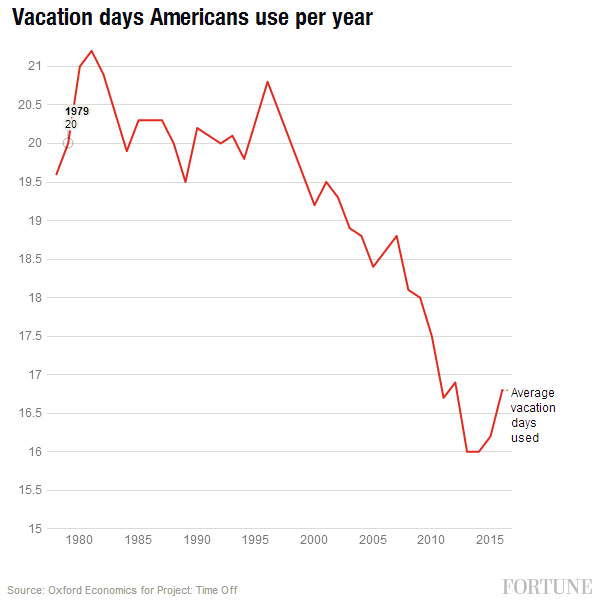老問題還無解:美國(guó)人不愛休帶薪假
|
這是個(gè)老問題了,,美國(guó)人就是不喜歡享受應(yīng)得的帶薪假期,。美國(guó)旅游協(xié)會(huì)本周二發(fā)布的“休假項(xiàng)目”研究顯示,2016年問題仍然存在,,54%參與調(diào)查的員工沒休完帶薪假,,合計(jì)犧牲了6.62億個(gè)假日。 雖然半數(shù)以上受訪員工拖到年底仍放棄了帶薪假,,但研究調(diào)查結(jié)果中也有一些亮點(diǎn),,說不定美國(guó)人可能改變有假不休的壞習(xí)慣。 2016年,,未能請(qǐng)帶薪假的員工占比實(shí)際上比2015年下降了一個(gè)百分點(diǎn),,降至54%。員工實(shí)際平均帶薪假天數(shù)為16.8日,,較2015年16.2日有所增加,,2013和2014年平均假期天數(shù)均為史上最低的16日。 “總體而言,,美國(guó)人利用的帶薪假在增加,,”“休假項(xiàng)目”高級(jí)主管、報(bào)告的執(zhí)筆者凱蒂?丹尼斯說,,“略見增長(zhǎng),。”她還說,,這可能是個(gè)轉(zhuǎn)折點(diǎn),,預(yù)示著今后合理休假會(huì)變?yōu)槌B(tài)。 |
It's become a perennial story: Americans are terrible at taking all of their allotted vacation days. That was true again in 2016, with 54% of employees ending the year with unused time off, collectively sacrificing 662 million vacation days, according to a study the U.S. Travel Association’s Project Time Off released Tuesday. While more than half of employees forfeited paid time off at year's end, some bright spots in the survey results hint that Americans may be in the process of reversing their bad vacation habits. The share of employees who failed to use all their vacation time was actually down one percentage point from 55% in 2015. And the average number of vacation days logged by employees—16.8—was up from 16.2 in 2015 and an all-time low of 16 in 2014 and 2013. " Overall Americans are using more vacation days," says Katie Denis, senior director of Project Time Off who authored the report. "There's been a slight uptick," she said, adding that it could be "the beginning" of a more significant turnaround. |

|
上升趨勢(shì)部分由男性員工帶動(dòng),。2016年48%的受訪男員工用完了所有帶薪假,,占比較2015年高3個(gè)百分點(diǎn)。盡管表示帶薪假期“極為”重要的女性占比為58%,,高于男性的49%,,卻只有44%的女性用完了帶薪假期。 整體來看,,2016年員工請(qǐng)假最大的挑戰(zhàn)是擔(dān)心返工時(shí)工作積壓太多,,另一個(gè)主要原因是認(rèn)為其他人無法勝任自己的工作。 這些擔(dān)憂可能沒什么根據(jù),,也可能有些夸張,,但管理者很少明確指出,。雖然絕大多數(shù)經(jīng)理都認(rèn)為,假期有助于員工的身心健康(82%),,提振士氣(82%),,減輕職業(yè)倦怠(81%),。三分之二的受訪員工表示,,“公司文化對(duì)休假的態(tài)度比較矛盾,并不很鼓勵(lì),,或者傳遞的信號(hào)不明確”,。2014年以來,有這種看法的員工占比幾乎沒變化,。 上述研究認(rèn)為,,溝通不善“導(dǎo)致了認(rèn)識(shí)‘真空’,引發(fā)了許多負(fù)面看法,?!?/p> “休假項(xiàng)目”估算,2016年浪費(fèi)的帶薪假給美國(guó)經(jīng)濟(jì)損失了2360億美元,,因?yàn)榧倨谠究衫瓌?dòng)消費(fèi),,而且員工的個(gè)人收入也有負(fù)面影響。項(xiàng)目研究認(rèn)為,,和大方享受帶薪假的員工相比,,放棄休假的員工績(jī)效較低,去年一年獲得擢升的可能性更低(前者可能性為27%,,后者為23%),,過去三年加薪或者獲得獎(jiǎng)金的可能性也更低(享受所有休假者為84%,,放棄休假者78%),。這么一看,放棄帶薪假的員工自稱壓力更大也正常,。(財(cái)富中文網(wǎng)) 譯者:Pessy 審稿:夏林 |
The positive trend was driven, in part, by men. Forty-eight percent of them used all their vacation time last year, up three percentage points from 2015. Just 44% of women, meanwhile, took all their allotted days off despite being more likely than men—58% to 49%—to say vacation time is "extremely" important to them. Overall, employees' concerns about returning to a mountain of work was the top challenge to taking time off in 2016, followed by the feeling that no one else can do the job. Those concerns may be unfounded or exaggerated, but workplace leaders fail to say so even though a clear majority of managers agree that vacation improves health and well-being (82%), boosts morale (82%), and alleviates burnout (81%). Two-thirds of employees surveyed said their "company culture is ambivalent, discouraging, or sends mixed messages about time off," a share that's virtually unchanged since 2014. That communication divide "has created a vacuum where negative perceptions thrive," the study says. Project Time Off estimates that unused vacation days cost the U.S. economy $236 billion in 2016 because of lost spending, but there are also penalties to pay at the individual level. Employees who forfeit vacation time are lower performers, the study says. Compared to counterparts who take all their vacation time, they are less likely to have been promoted within the last year (23% to 27%), and to have received a raise or bonus in the last three years (78% to 84%). And, unsurprisingly, they are more likely to report being stressed. |













